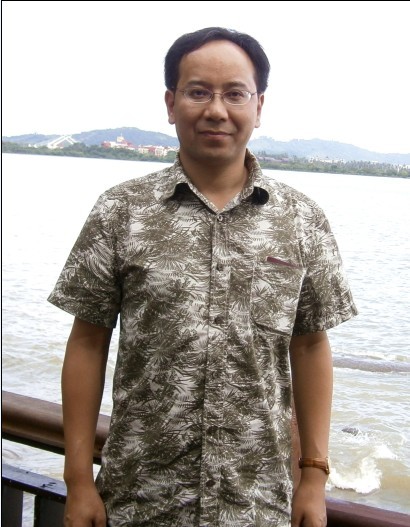
个人简介
潘林强,2000年毕业于南京大学,获理学博士学位。2000年至2002年在华中科技大学控制理论与工程博士后流动站从事博士后研究,出站后留校任教。现任华中科技大学pbb63365挎包教授、博士生导师。
长期从事生物计算与生物信息处理的科研和教学。主持国家自然科学基金7项(其中重点项目1项,重大国际合作项目1项),教育部高校博士点基金3项。在IEEE Transactions on Neural Networks and Learning Systems,IEEE Transactions on Nanobioscience,IEEE/ACM Transactions on Computational Biology and Bioinformatics, Journal of Complexity等国际期刊发表SCI收录论文80余篇。2005年入选教育部新世纪优秀人才计划。曾获教育部自然科学一等奖(第一完成人),湖北省自然科学一等奖(第二完成人)。
潘林强教授是湖北省运筹学学会理事长,中国电子学会图论与系统优化专业委员会副理事长。
主要研究方向
人工智能,复杂网络,生物计算,生物信息处理
招生要求(专业需求和招生方向)
专业需求:计算机科学与技术,数学,自动化,生物学,纳米技术等
招生方向:生物信息、控制与计算
代表性成果及获奖情况(论文、科研或奖励情况)
代表性论文:
[1]Linqiang Pan, Gheorghe Paun, Spiking Neural P Systems: An Improved Normal Form, Theoretical Computer Science, 411(2010), 906-918
[2]Jun Wang, Hendrik Jan Hoogeboom, Linqiang Pan, Gheorghe Paun, Mario J. Pérez-Jiménez, Spiking Neural P Systems with Weights, Neural Computation, 22(10)(2010), 2615-2646
[3]Linqiang Pan, Mario J. Pérez-Jiménez, Computational Complexity of Tissue-like P Systems, Journal of Complexity, 26(3)(2010), 296-315
[4]Tseren-Onolt Ishdorj, Alberto Leporati, Linqiang Pan, Xiangxiang Zeng, Xingyi Zhang, Deterministic Solutions to QSAT and Q3SAT by Spiking Neural P Systems with Pre-Computed Resources, Theoretical Computer Science, 411(2010), 2345-2358
[5]Zhang Xingyi, Wang Shuo, Niu Yunyun, Pan Linqiang, Tissue P systems with cell separation: attacking the partition problem, Science China Information Sciences, 54(2) (2011), 293-304.
[6]Linqiang Pan, Xiangxiang Zeng, Xingyi Zhang, Time-Free Spiking Neural P Systems, Neural Computation, 23(2011), 1320–1342
[7]Pan Linqiang, Paun Gheorghe, Perez-Jimenez Mario J., Spiking neural P systems with neuron division and budding, Science China Information Sciences, 54(8)(2011), 1596-1607
[8]Linqiang Pan, Xiangxiang Zeng, Small universal spiking neural P systems working in exhaustive mode, IEEE Transactions on Nanobioscience, 10(2)(2011), 99 - 105.
[9]Jin Xu, Xiaoli Qiang, Yan Yang, Baoju Wang, Dongliang Yang, Liang Luo, Linqiang Pan, Shudong Wang, An unenumerative DNA computing model for vertex coloring problem, IEEE Transactions on Nanobioscience, 10(2)(2011), 94-98.
[10]Linqiang Pan, Xiangxiang Zeng, Xingyi Zhang, Yun Jiang, Spiking Neural P Systems with Weighted Synapses. Neural Processing Letters, 35(1)(2012), 13-27
[11]Xingyi Zhang, Bin Luo, Xianyong Fang, Linqiang Pan, Sequential spiking neural P systems with exhaustive use of rules, BioSystems, 108 (2012), 52– 62
[12]Linqiang Pan, Jun Wang, Hendrik Jan Hoogeboom, Spiking Neural P Systems with Astrocytes, Neural Computation, 24(3)(2012), 805-825
[13]Tao Song, Linqiang Pan, Jun Wang, Ibrahim Venkat, K. G. Subramanian, Rosni Abdullah, Normal Forms of Spiking Neural P Systems With Anti-Spikes, IEEE Transactions on Nanobioscience, 11(4)(2012), 352-360
[14]Xiangxiang Zeng, Tao Song, Xingyi Zhang, and Linqiang Pan, Performing Four Basic Arithmetic Operations with Spiking Neural P Systems, IEEE Transactions on Nanobioscience, 11(4)(2012), 366-374
[15]Tao Song, Linqiang Pan, Gheorghe Paun, Asynchronous spiking neural P systems with local synchronization, Information Sciences, 219(2013), 197–207
[16]Tao Song, Linqiang Pan, Keqin Jiang, Bosheng Song and Wei Chen, Normal Forms for Some Classes of Sequential Spiking Neural P Systems, IEEE Transactions on NanoBioscience, 12 (3)(2013), 255-264
[17]Keqin Jiang,, Tao Song, Linqiang Pan, Universality of Sequential Spiking Neural P Systems Based on Minimum Spike Number, Theoretical Computer Science, 499(2013), 88-97
[18]Xiaolong Shi, Wei Lu, Zhiyu Wang, Linqiang Pan, Guangzhao Cui, Jin Xu, Thomas H LaBean, Programmable DNA tile self-assembly using a hierarchical sub-tile strategy, Nanotechnology, 25(7)(2014), 075602
[19]Tao Song, Luis F. Macías-Ramos, Linqiang Pan, Mario J. Pérez-Jiménez, Time-free Solution to SAT Problem Using P Systems with Active Membranes, Theoretical Computer Science, 529(2014), 61–68.
[20]Tao Song, Linqiang Pan, Gheorghe Paun, Spiking Neural P Systems with Rules on Synapses, Theoretical Computer Science, 529(2014), 82–95.
[21]Xingyi Zhang, Xiangxiang Zeng, Bin Luo, Linqiang Pan, On Some Classes of Sequential Spiking Neural P Systems, Neural Computation, 26(2014), 974—997
[22]Xiangxiang Zeng, Linqiang Pan, Mario J. Perez-Jimenez, Small Universal Simple Spiking Neural P Systems with Weights, Science China Information Sciences, 57(9)(2014), 1-11
[23]Su, Yansen, Pan, Linqiang, Identification of Logic Relationships between Genes and Subtypes of Non-Small Cell Lung Cancer, PLOS ONE 9(4) (2014): e94644.
[24]Liu Xueming, Pan Linqiang, Detection of driver metabolites in the human liver metabolic network using structural controllability analysis, BMC Systems Biology, 8(51)(2014), DOI: 10.1186/1752-0509-8-51
[25]Xingyi Zhang, Yanjun Liu, Bin Luo, Linqiang Pan, Computational power of tissue P systems for generating control languages, Information Sciences, 278(2014), 285–297.
[26]Xiangxiang Zeng, Lei Xu, Xiangrong Liu, Linqiang Pan, On languages generated by spiking neural P systems with weights, Information Sciences, 278(2014), 423–433.
[27]Xiangxiang Zeng, Xingyi Zhang, Tao Song, Linqiang Pan, Spiking Neural P Systems with Thresholds, Neural Computation, 26(2014), 1340-1361.
[28]Gexiang Zhang, Marian Gheorghe, Linqiang Pan, Mario J. Pérez-Jiménez, Evolutionary membrane computing: A comprehensive survey and new results, Information Sciences, 279(2014), 528-551
[29]Xiaolong Shi, Zhiyu Wang, Chenyan Deng, Tao Song, Linqiang Pan, Zhihua Chen, A Novel Bio-Sensor Based on DNA Strand Displacement, PLoS ONE 9(10)(2014): e108856.
[30]Xingyi Zhang, Bangju Wang, Linqiang Pan, Spiking neural p systems with a generalized use of rules, Neural Computation, 26(12) (2014), 2925--2943.
[31]Yang, Jing; Dong, Chen; Dong, Yafei; Liu, Shi; Pan, Linqiang; Zhang, Cheng, Logic nanoparticle beacon triggered by the binding-induced effect of multiple inputs, ACS Applied Materials & Interfaces, 6(16) (2014), 14486-14492
[32]Bosheng Song, Linqiang Pan, Computational Efficiency and Universality of Timed P Systems with Active Membranes, Theoretical Computer Science, 567(2015), 74-86
[33]Xueming Liu, Linqiang Pan, Identifying driver nodes in the human signaling network using structural controllability analysis, IEEE/ACM Transactions on Computational Biology and Bioinformatics, 12(2)(2015), 467-472.
[34]Xingyi Zhang, Linqiang Pan, Andrei Paun, On the Universality of Axon P Systems, IEEE Transactions on Neural Networks and Learning Systems, DOI: 10.1109/TNNLS.2015.2396940
[35]Tao Song, Linqiang Pan, Spiking Neural P Systems With Rules on Synapses Working in Maximum Spikes Consumption Strategy, IEEE Transactions on NanoBioscience, DOI: 10.1109/TNB.2014.2367506
[36]Tao Song, Linqiang Pan, Spiking Neural P Systems with Rules on Synapses Working in Maximum Spiking Strategy, IEEE Transactions on NanoBioscience, DOI: 10.1109/TNB.2015.2402311
[37]Bosheng Song, Tao Song and Linqiang Pan, A time-free uniform solution to subset sum problem by tissue P systems with cell division. Mathematical Structures in Computer Science, 2015, doi:10.1017/S0960129515000018
[38]Bosheng Song, Mario J. Pérez-Jiméne, Linqiang Pan, Efficient solutions to hard computational problems by P systems with symport/antiport rules and membrane division, BioSystems, 130(2015), 51–58,
[39]Luis F. Macías-ramos, Bosheng Song, Luis Valencia-Cabrera, Linqiang Pan, Mario J. Pérez-jiménez, Membrane fission: A computational complexity perspective, Complexity, DOI: 10.1002/cplx.21691
科研项目:
主持完成项目:
(1)国家自然科学基金面上项目四项(60103021,60373089,60674106,30870826)
(2)西班牙教育文化体育部人才项目一项(DGU-SB2001-0092)
(3)教育部新世纪优秀人才计划一项(NCET-05-0612)
(4)高校博士点基金项目一项(20060487014,20100142110072)
(5)武汉市晨光计划项目一项(200750731262)
(6)湖北省杰出青年基金项目一项(2008CDB113)
(7)国家自然科学基金重点项目:基于细胞(膜和核酸)的计算模型和算法研究(61033003,2011年-2014年)
(8)国家自然科学基金重大计划培育项目:肺癌细胞周期的建模方法和动力学研究(91130034,2012年-2014年)
(9)湖北省自然科学基金重点项目:基于细胞启发的新型算法及应用研究(2011CDA027,2012年-2014年)
在研项目:
(1)高校博士点基金优先发展领域:基于分子计算的非传统信息处理技术(20120142130008,2013年—2015年)
(2)国家自然科学基金重大国际合作项目:基于细胞的膜计算系统以及在生物学中的应用(61320106005,2014年-2018年)
获奖:
[1] 2007年,湖北省自然科学一等奖
[2] 2014年,教育部自然科学一等奖